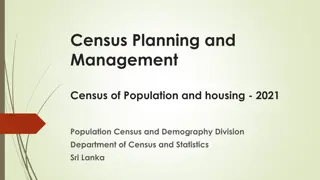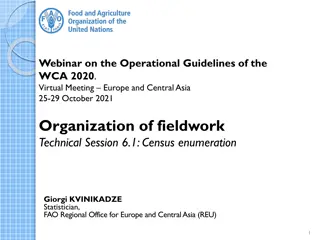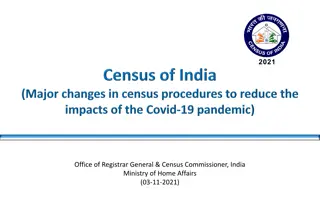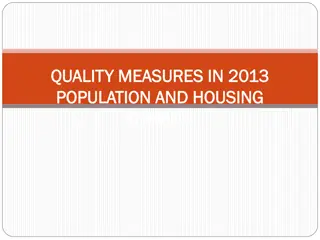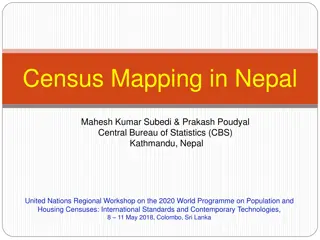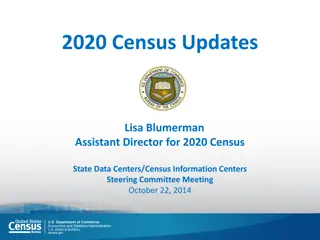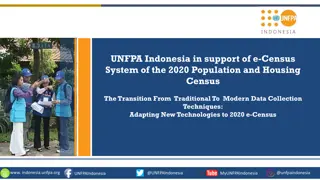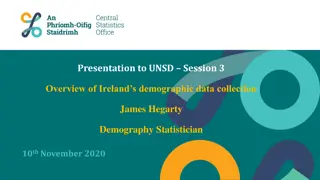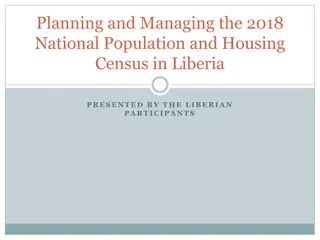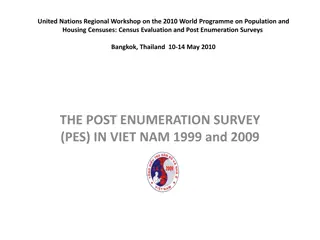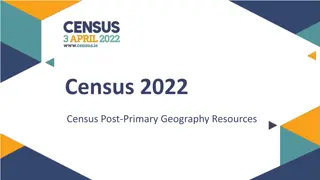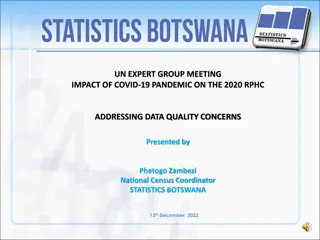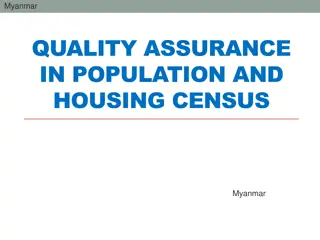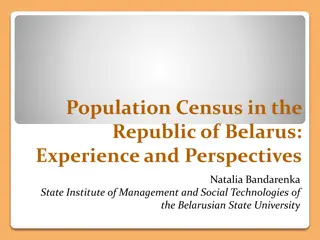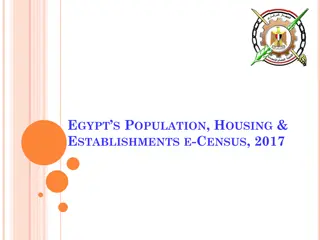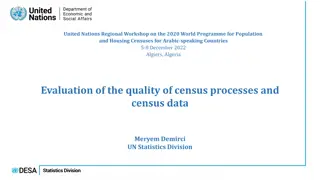Census Administrator Training Information
This training provides detailed information on Census Administrator responsibilities, confidentiality requirements, preparation steps, considerations for annexation census, quality assurance, and more. Visual elements include data forms and maps to ensure accessibility. For assistance or questions, contact the Office of Financial Management.
Download Presentation

Please find below an Image/Link to download the presentation.
The content on the website is provided AS IS for your information and personal use only. It may not be sold, licensed, or shared on other websites without obtaining consent from the author. Download presentation by click this link. If you encounter any issues during the download, it is possible that the publisher has removed the file from their server.
E N D
Presentation Transcript
CENSUS ADMINISTRATOR TRAINING
NOTE: This training contains visual elements including data forms and geographical maps. To meet accessibility standards, visual elements are tagged and/or described in readable text. If you have any difficulty or need assistance accessing any of the information contained in this training, please contact the Office of Financial Management, Forecasting and Research Division, by phone at 360-902-0599, or by email at pop.annexations@ofm.wa.gov
Table of Contents General Information Pre-Census Preparation Monitoring Census Progress Tabulation and Filing Procedure 3
Must Keep Information Confidential The Census information that you collect is confidential and protected by law. Copied below is RCW 42.56.615 that guarantees confidentiality. RCW 42.56.615 Enumeration data used by the office of financial management for population estimates. Actual enumeration data collected under RCW 35.13.260, 35A.14.700, 36.13.030, and chapter 43.62 RCW shall be used and retained only by the office of financial management and only for the purposes of RCW 35.13.260, 35A.14.700, 36.13.030, and chapter 43.62 RCW. The enumeration data collected is confidential, is exempt from public inspection and copying under this chapter, and in accordance with RCW 43.41.435, must be destroyed after it is used. [ 2014 c 14 1.] 5
Census Considerations Annexation census is required by law. Per RCW 35.13.260 and RCW 35A.14.700, cities/towns must enumerate residents in an annexed area and file with OFM for certification. April 1 census can replace OFM estimate. Cities may chose to census instead of using OFM estimate for funding allocation if it believes that federal decennial census or OFM estimate are not accurate. 6
Census Quality A census is an investment of time and resources for both the city and OFM. A census administrator and his/her staff must follow OFM specifications to achieve a quality census that OFM will approve. OFM may reject all or parts of a census where administrators/enumerators failed to follow OFM procedures. A rejected annexation census will result in a partial or total re-do of the census. A rejected April 1 census will result in a population estimate for that year. 7
Pre-Census Preparations The administrator must complete the preparation for the following five areas before the census date: Identify a census window Staffing Training Mapping census area Office space, publicity, and census supplies It is important to plan early since pre-census activities can take a large amount of time. 9
Identify Census Window A census should be completed within 30 days. An annexation census cannot start before it is legally effective. And, by statute, the documentation has to be sent to OFM within 30 days of the effective date. o With preapproval, the enumeration period may be extended up to two weeks prior to the effective date. April 1 city wide census used in place of OFM April 1 estimates may only be conducted during the time frame specified by OFM. See: http://www.ofm.wa.gov/pop/april1/info.asp for more information. 10
Suggested Schedule Pre-Census Preparations: Start 3-4 weeks before Day 1 with hiring/identifying administrator Hire supervisor 1-2 weeks before day 1 in field Hire enumerators and train 1-2 days before day 1 in field Day 1 in field with census: First day enumerators in the field canvassing and counting population Initial Canvass: Occurs over first 7 to 10 days Visit and list all residences in census area at least once Finish Census 10 to 20 days: Clear all callbacks; can occur during initial canvass days Submit all sheets and maps to OFM: Designated last day 11
Use City Staff vs Hire Contractor Use an estimated population for the area to get a sense of the time needed. If administrator, supervisors and/or enumerators will be comprised of city staff, make sure their other duties will not conflict with census work. Census work takes priority. Weekend and evening hours should be required. If city staff do not have the time/skills needed to conduct a census or the census is large, consider hiring a contractor to do the entire census. If you decide to hire a contractor keep in mind that for a larger census they need to be onboard 3 to 4 weeks before fieldwork begins. The contractor must use OFM training materials him/herself and understand the requirements. The city must monitor the contractor and make sure OFM procedures are being followed. 12
Obtain Insurance The state does not assume any liability for conducting the census. Insurance coverage is the city s responsibility. Decisions about insurance should be made before hiring anyone. 13
Hire Supervisors Responsibilities: Assigning work to the enumerators, gathering and checking all completed census sheets, evaluating enumerators job performance, and assisting the administrator. Depending on the work load the supervisors can enumerate as well. Qualifications: Must have good communication skills, a good understanding of census procedures and requirements, and be able to manage the daily operation of the census canvassing process Time of hire: Supervisors should be hired one to two weeks prior to the census to learn the job and be able to train the enumerators and provide assistance to the administrator Number of supervisors needed: Usually 1 supervisor for every 5 to 10 enumerators is efficient. 14
Hire Enumerators Enumerators should be hired early enough for training. They should: be able to maintain confidentiality. be able to read census maps. be meticulous and willing to ask questions. be able to work evenings and weekends and have good physical endurance Good enumerators are key to a good quality census. Applicants should be screened carefully. And they need to be evaluated daily once hired. 15
How Many Enumerators Are Needed? The number of enumerators needed depends on: Size of the annexation How difficult the area will be to enumerate at the time of the census. Factors affecting difficulty include: o Housing density o Attitudes towards government and/or the annexation o High crime area o Bad weather and evening darkness can slow down the cavass speed. o Holiday seasons can be difficult time to capture residents at home. o Work hours are influenced by the need to catch people at home. 16
Staffing Level Estimation Estimated population in census area Average persons counted per day by 1 enumerator (2) Days for 1 enumerator to cover annexed area Days for initial canvass of annexed area Number of enumerators needed (1) (3)= (1)/(2) (4) (5)= (3)/(4) 10,000 150 66.7 7 9.5 10,000 150 66.7 10 6.7 5,000 150 33.3 7 4.8 2,500 150 16.6 7 2.4 800 150 5.3 7 0.8 800 50 16.0 7 2.3 Note: Above numbers are based on a typical urban, not rural, density. [except second 800 population example] 17
Payment of Enumerators How census staff is paid is determined by the city or contractor. The state does not pay for census costs. Paying enumerators per name or address collected is not advisable. 18
Enumerator Training 1. Each enumerator should do the following training: Read the enumerators manual Take the on-line training Participate in one office training session Attend one field performance training 2. Additional review sessions may be necessary to deal with unique situations or when there is confusion 19
Census Manuals Be advised that the OFM training presentation, or the training provided by census administrator, does not substitute for reading the manuals. OFM has posted the PDF versions of the manuals online at: http://www.ofm.wa.gov/pop/annex/forms/default.asp The three manuals found online are: o Census Administrator Manual o Census Enumerator s Manual o Census Tabulation Manual Each person should read the manual(s) that pertains to his/her job. 20
Enumerator In-Office Training The office training should achieve the following goals: All enumerators must understand confidentiality rules and agree to follow them. All enumerators need to understand the housing unit/facility concepts. All enumerators need to understand the definition of a resident. All enumerators need to understand canvassing techniques and read maps well. All enumerators need to have interviewing skills. Everyone should practice interviews with one another in the office Every enumerator should read the enumerator s manual before the in-office training. Then practice interview techniques and fill out practice field enumeration sheets. They should thoroughly understand the concepts listed above before going into the field. 21
Enumerator Field Training The administrator/supervisor should take trainees to the field for a test. Ask a trainee to determine the first house to be enumerated One at a time each enumerator should go to a housing unit to conduct the interview with the supervisor observing. Afterwards, the whole team should critique each interview. Check and recheck each person s understanding of census definitions before that person is released in the field to enumerate on their own 22
Residences with No-Trespassing Sign Do not approach a house with a No-trespassing sign Talk to city/town attorney and/or sheriff in advance about No Trespassing signs and how they affect enumeration Try to collect information from the neighbors Try to find phone number of the household and enumerate over the phone 23
Create Census Maps The Master Control Map is an important census tool for the administrator because it shows the entire census area and can be used to track progress. Besides the Master Control Map, supervisor and enumerator maps are needed. All maps need to be marked in a specific manner. Instructions on how to create census maps are included in census mapping training section. 24
Location for Census Headquarters Locate a secure location to house census documentation and for census administrator to work If at city hall, find an office that can be locked when no census worker is present. This room cannot be used for any other function. If not at city hall, rent a place just for the census. You can not use a person s dining room, or leave census materials in the family car. A dedicated phone line is necessary for residents questions. 25
Prepare Census Badges All census personnel need to have picture ID badges Badges should have a specified effective period Enumerators should return the badges as soon as their employment is terminated 26
Prepare Confidentiality Agreement A confidentiality agreement is a very useful tool for the census. This document is signed by both the mayor and the enumerator. It serves two purposes. It verifies that the enumerator is hired by the city and that he/she has sworn to never share the census information with anybody. The enumerator needs to show this agreement to the residents before the interview. Once the authenticity of the enumerator and the confidentiality of the data are established, residents are more cooperative. 27
Example of Mayors Letter/ Confidentiality Agreement 28
Prepare Publicity Problems and bad attitudes can be tempered with proper publicity. The following methods have been used effectively in the past: Newspaper articles Insert a flyer in utility billing Electronic bulletin board at road entrances to the census area Social media Notifying law enforcement about enumeration plans 29
Prepare Materials in Other Languages Certain areas may contain a large non-English speaking population. If possible, identify those blocks while you are updating the master control map. If possible hire enumerators that speak identified languages. Print explanation/informational handouts/door-hangers in applicable languages Print Confidentiality Agreement in applicable languages Print pre-census publicity in applicable languages Have all enumerators carry a copy of alternate language material. 30
Print and Prepare Field Enumeration Sheet The Administrator needs to know, and be familiar with, all census forms. OFM paper forms must be used and can be found on our website at: http://www.ofm.wa.gov/pop/annex/forms/default.asp For enumeration you need OFM Census Sheet A Field Enumeration Sheet Pre-enter the city/town name and year or ordinance number only. Need one sheet per housing unit, whether occupied or vacant Do not use any electronic means to collect and store name and address information. Confidentiality cannot be guaranteed. 31
Contact Group Quarter Facilities When a group of unrelated persons live together in a facility, such a living arrangement is called group quarters (GQ). Examples of GQ s include: military barracks, and student dorms. For more details on GQ definitions, please go to the enumerator training. The administrator should locate such facilities prior to the start of the census, preferably during the field check of the master control map. Then contact the facility and ask them to prepare a list of all residents as of April 1st (for a city census) or as of an annexation effective date. Ask them to include the facilities' administrator s name and phone number. The enumerator will pick up the list of residents as he/she works the block the group quarter facility is located in. 32
Contact Large Multi-Unit Structures and Gated Communities All large multi-unit structures should be contacted, preferably prior to the census. Contact the appropriate management. Explain census activities. Ask that a list of vacancies be prepared for the approximate date the enumerators are scheduled to come through the block. Explain the difference between occupied and rented . You can never share the census information with the managers under any circumstance. For gated communities, make arrangements to get in over a certain period to complete the census. 33
Contact Other Unique Housing 1. Contact Shelters/Youth homes/ Hotels Motels in advance o Contact the managers and tell them about the census and its purpose o Let them know the dates when enumerators are coming. o Ask them to be prepared to provide housing and resident information o Shelters for abused women may not be willing to give names. In these cases, mark Refused . o Juvenile group homes are not allowed by law to give names. Be sure to get counts per unit. o Hotels/motels may have units that can be counted as housing units 2. Make arrangements for homeless encampments. Contact the service agencies that currently work with the homeless in this area for help and advice. 3. See the Enumerator training for detailed instructions on how to handle these unique housing. 34
Pre-prepared List for Callback Utility or county assessor s records can help determine if the unit is being used. Names from these sources can be used to locate phone numbers for contact purposes only. Names found via administrative sources should not be used by itself to enumerate the household. The owner of the house may not be the same as residents who occupy the house. The homeowners may also have other people (kids, relatives, roommates) living in the household. It may take enumerators multiple times before reaching the residents. If residents are very difficult to reach, the unit may be held for occasional use. Until proven otherwise, it is vacant. 36
Prepare Census Supplies Each enumerator should take the following materials out in the field: Photo ID badge Call back forms 3-ring binders Individual confidentiality agreements Census map (with block and enumeration path identified) No. 2 Pencils (no pens) OFM Census Sheet A - Field Enumeration Sheet (with only city, ordinance number/year entered) Blank paper for recording questions, situations for later conversation with supervisor 37
Monitoring Census Progress Census progress must be monitored closely and resolve issues and problems immediately 1. Meet with enumerators daily. Collect all completed forms, including callback sheets. Evaluate completion of the forms. Assign the next day s enumeration areas and work schedule. You can start clearing callbacks as soon as you have them. All attempted contact should be documented. 2. Record and update the number of completed units and the number of callbacks by block. 3. Record progress daily on the master control map. 4. Keep Field Enumeration Sheets organized by block and by housing unit sequence number. Three-ring notebooks work great for this. 39
Enumerator Safety Contact the local police to let them know a census is being conducted o Let them know enumerators will be in the field. o Provide enumeration dates, the enumeration location, and enumerators names. Each enumerator should carry a cell phone and should contact emergency services (e.g. 911) first in case of emergency. Send enumerators to the field in pairs when there is concern about safety. Be sure your enumerators understand safety policies and procedures Be dressed appropriately for the weather Wear high visibility clothing and bring flashlights for night work. IMPORTANT: Be alert and pay attention to current news. You may not be aware of hazardous situations until the enumerators are in the field. Be prepared to make adjustments like changing their work location as needed on a moments notice. 40
Evaluating Enumerators Administrator /supervisor should evaluate the enumerators on daily basis. Make assessments in the first couple of days to find and keep those with high performance. Those who Submit more completed forms, and fewer refusals, Can get better neighbor cooperation And have more complete names of residents And let go of those unable to do the job, especially as the workload decreases with each day s progress. 41
Common Mistakes Underestimate the time required to do a census Underestimate the number of enumerators needed Unclear chain of command / responsibilities Inadequately prepared maps Inadequate checking of enumerator/supervisor performance Inadequate checking of census progress Failure to use pre-census publicity materials 42
Tabulating Census Results Field Enumeration forms (Sheet A) need to be tabulated. OFM tabulation forms must be used. Tabulation instructions are included in a separate manual and online training. OFM s advice is: Either do the tabulation yourself Or have a good enumerator do the tabulation. Enumerators should not tabulate their own forms. 44
Submit Census Documentation 1. All documents are required to be sent to OFM. These documents include: All completed Sheet A- Field Enumeration Sheets All completed Sheet B Block -Tabulation Sheets All completed Sheet C -Block Group Tabulation Sheets Sheet D - Summary Tabulation Sheet 2. Do not copy Census Sheet A for any reason. 3. Deliver in person or mail all documentation by a method that has a tracking system. Such requirement is to comply with the confidentiality statute. OFM must ensure that all confidential information is destroyed when appropriate. This procedure also protects local governments from public disclosure requests regarding these census records. 45
Filing with OFM Send all documentation to: Forecasting and Research Division Office of Financial Management P.O. Box 43124 Olympia WA 98504-3124 If using FedEx, UPS, etc.: Forecasting and Research Division Office of Financial Management Room 2200 106 11th Ave SW Olympia WA 98501 If you have questions about a census, census definitions and/or procedures, please contact us at: Forecasting and Research Division Pop.annexations@ofm.wa.gov 360-902-0599 46


